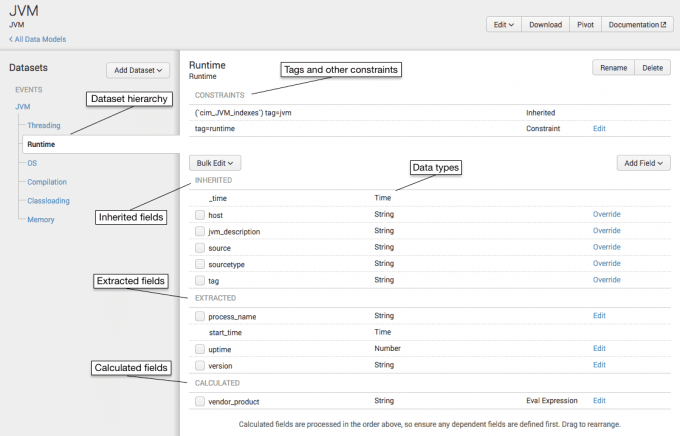How to use these reference tables
Each topic in this section contains a use case for the data model, a breakdown of the required tags for the event datasets or search datasets in that model, and a listing of all extracted and calculated fields included in the model.
Note: A dataset is a component of a data model. In versions of the Splunk platform prior to version 6.5.0, these were referred to as data model objects.
How to read the tags tables
The tags tables communicate which tags you must apply to your events in order to make them CIM-compliant. These tags act as constraints to identify your events as relevant to this data model, so that this data is included in Pivot reports, searches, and dashboards based on this model.
There might be additional constraints outside the scope of these tables. Refer to the data model itself using its editor view in Splunk Web for required fields, field=value combinations, or base searches that the model depends on.
Ensure your data is populated in the correct dashboards, searches, and Pivot reports.
- Identify the CIM data model relevant to your events.
- Identify the dataset within that model that is relevant to your events.
- Observe which tags are required for that dataset.
- Observe which tags are required for any parent datasets.
- Observe any other constraints relevant to the dataset or its parents.
- Apply those tags and other constraints to your events using event types.
- Repeat for any additional relevant CIM datasets.
For a detailed walkthrough of these steps, see Use the CIM to normalize data at search time.
How to read the fields tables
The fields tables list the extracted fields and calculated fields for the event and search datasets in the model and provide descriptions and expected values (if relevant) for these fields. The table presents the fields in alphabetical order, starting with the fields for the root datasets in the model, then proceeding to any unique fields for child datasets. The table does not repeat any fields that a child dataset inherits from a parent dataset, so refer to the parent dataset to see the description and expected values for that field.
Because the fields tables exclude inherited fields, many child datasets have no fields listed in the table at all. Those child datasets include only inherited fields from one or more of their parent datasets, so there are no unique extracted or calculated fields to display. All data models inherit the fields _time, host, source, and sourcetype, so those fields are always available to you for use in developing Pivot reports, searches, and dashboards.
Use the tables to apply the Common Information Model to your data
The tables in this section of documentation are intended to be supplemental reference for the data models themselves. Use the documentation and the data model editor in Splunk Web together.
Prerequisite
You need Write access to a data model in order to browse it in its editor view. If you do not have this access, request it from your Splunk administrator.
Steps
- In Splunk Web, go to Settings > Data Models to open the Data Models page.
- Click a data model to view it in an editor view. There, you can see the full dataset hierarchy, a complete listing of constraints for each dataset, and full listing of all inherited, extracted, and calculated fields for each dataset.
- Compare this information with the reference tables in the documentation for descriptions and expected values of the fields in each datasets.
| Information available in documentation |
Information available in Data Model Editor in Splunk Web | |
|---|---|---|
| Required tags | YES | YES |
| Other constraints | NO | YES |
| Full dataset hierarchy | NO | YES |
| Inherited fields | NO | YES |
| Extracted fields | YES | YES |
| Calculated fields | YES | YES |
| Data types | YES | YES |
| Descriptions | YES | NO |
| Expected values | YES | NO |
| Support and resource links for the Splunk Common Information Model Add-on | Alerts |
This documentation applies to the following versions of Splunk® Common Information Model Add-on: 4.6.0

 Download manual
Download manual
Feedback submitted, thanks!